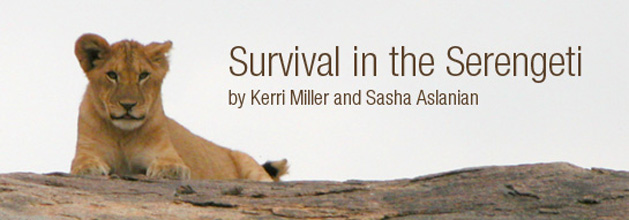
The East African nation of Tanzania is rich in wildlife, but with a growing human population, conflicts between people, lions and elephants are growing more frequent. A University of Minnesota evolutionary biologist is working to diffuse these conflicts. But some of his efforts have made him controversial.
Listen to the radio documentary Survival in the Serengeti, read parts 1, 2, and 3, or join Kerri Miller and Sasha Aslanian for a continuing discussion.
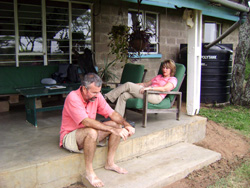
MORE FROM MPR
Palin speaks in St. Paul whileSeptember 3, 2008
Slideshow: Tuesday's protests and arrests
September 2, 2008
RESOURCES
Services
The Splendor of the Serengeti
by Kerri Miller and Sasha Aslanian, Minnesota Public RadioIt's nightfall at Lion House, Craig Packer's research station in Serengeti National Park. A pair of elephants forages 30 feet from where we're standing. We can hear their heavy footsteps and chewing and breathing in the darkness. We turn the flashlight off and listen to the night sounds of the Serengeti all around us.
Lion House is just a feature in the landscape to the animals passing by. Other than the small cluster of research houses near the airstrip, the Serengeti is wide open grasslands sprawling the size of Connecticut. There are no fences here. That's what makes this place like no place else on earth. More than a million wildebeest make their annual migration through here. The wildlife is abundant and unrestrained.
As Smart as They Need to Be
Craig Packer is at home here. The native Texan first came to Tanzania to work for Jane Goodall on her famous chimpanzee and baboon research in the early 1970s. He abandoned his plans to become a doctor.
Primates are smart. "When you look into a baboon's eyes, you can see the gears turning, some calculations going on," says Packer. So when he began studying lion behavior a few years later, he says he found lions hard to relate to. "When you look into a lion's eyes, all I could see was cold fish." Packer says he downplayed the intelligence of lions until he realized, "They're as smart as they need to be."
In fact, Packer's team was able to prove that lions can count in nature. It turns out to be a crucial survival skill. "One of the things I have to know is, 'How big is my neighbor's pride?' Because if I make a mistake on this, they'll outnumber me and they'll kill me." Packer says almost every lion dies because it's killed by another lion.
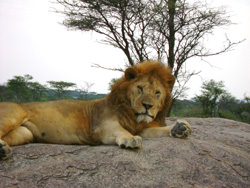
But it wasn't the brutality of lions that interested Packer. It was their ability to cooperate. They're the only big cats that do. Lion prides work together to hunt, raise their young and guard their territory. To seem them in action and note everything they did down to the most minute detail, Packer and a graduate student did a series of stake-outs. In six-hour shifts they took turns observing a pride over four days. It wasn't easy "trying to stay vaguely interested in a blob that's asleep under a tree or in some tall grass a couple hundred meters away. It was horrible. I hated it," Packer says with a laugh. But he got the data.
A Tenacious and Focused Researcher
Packer wanted to get inside the mind of a lion and understand what they were communicating to one another. He made recordings of lion roars and then played them back on speakers to other prides of lions to watch their reactions. He describes the scene with amusement. "You've got all these lounge lizards lying on the grass sleeping away the afternoon, not going to do anything for the foreseeable future. And you blast out a roar from a lion these guys have never heard before!" Packer with his long, limber frame imitates lions jumping to full attention at the sound of an invader on their turf. "What was that? It's not just that there's a lion in our home territory. That's a lion that feels confident enough to actually roar in our home territory!"
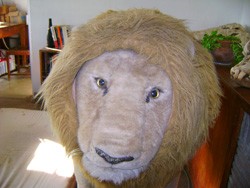
It turns out the lion roars are packed with information. "It communicates who I am. It communicates if I'm a male or female and it communicates how many of us there are." Other experiments using large stuffed lions tested whether female lions were more attracted to males with light or dark manes (they prefer dark) and confirmed Darwin's theory that manes are for ornamentation, not protection. A lion attacks his rival on the hindquarters or legs. He doesn't need to go for the jugular. All he needs to do is gouge a wound and infection will take care of the rest.
But it's been years since Packer did his own lion tracking. Now he spends half his time teaching at the University of Minnesota, and the other half doing research outside the parks. Here in the Serengeti, two full-time researchers now do the day-to-day work of tracking the lions.
Tracking Lions
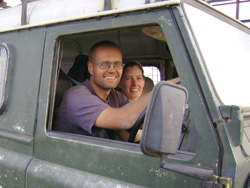
We head out one morning with Patrik Jigsved. He's a Swedish forester who fell in love with the Serengeti when he came here as a tourist years ago. Now he wrestles a Land Rover off-road making visits to 25 lion prides each week. A female in each pride wears a radio collar. Jigsved dials in the frequency, and turns the car in tight circles so the rooftop antenna can pick up the signal from the lion's collar.
We plunge across the bumpy savannas, crossing brooks and dodging spiny Acacia trees. Suddenly we see round golden ears peeking over the tall grass and Jigsved kills the motor. We watch a lioness, her sister and five cubs settle back down in the grass. "If we get too close they are a bit scared," Jigsved explains. But he's learned to break the stare by blinking and it seems to soothe the lions.
The Nerve Center
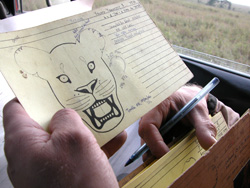
Jigsved makes a quick sketch of the cubs' ears and whisker spots so he can keep track of them on the next visit. He notes their location on the GPS, snaps some photographs and heads back to Lion House to load the morning's images onto his computer. Lion House bears the souvenirs and mementos of researchers who have carried on this work for decades. Lion skulls line the mantel and there are colored maps of lions' territories hanging on the walls. But the nerve center of the whole project--with its high-tech radio collars, solar-powered computers and digital photography-- is a rough plywood box.
Inside are hundreds of cards for the lions that Packer's team is tracking. The cards are dog-eared and stained, and each has an outlined drawing of a lion's head on it and digital photographs on the back. Most are full of notations: notches in the lion's ears, scars and freckles on their faces. They're grouped by pride. He named some of the prides, and some he inherited when he took over the Serengeti Lion Project in 1978. Over time he's been able to see how prides grow, divide or die off.
Packer flips through the cards, reading off the nicknames his field staff have given the animals. "Bassilis, Babbler, Baffle, Bays-what's Bays? Bakelight-that's gotta be a Brit." He calls himself the mortician, removing cards of lions that are probably dead. "Now Beatrice, Boosoo and Betty have all bit it."
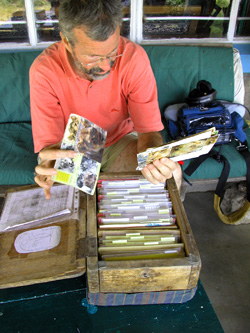
The plywood box adds up to a complex social history of lions. "The point of all this is just to keep track of who's who, so you know over their lifetime, you know at what age they started breeding, when their first cubs were born, how many cubs they had, each time they gave birth, how well their cubs survived," says Packer. "And then by just doing this all the time, we get a picture of lion life history."
Packer's been able figure out how lions are affected by disease outbreaks, natural disasters and even climate change. He has also learned how vulnerable these animals are to threats outside the park.
Crashing at the Gates: Looking Outside the Serengeti
1994 was a turning point for Packer's work. He had been running the Serengeti Lion Project for 16 years and noticed something alarming. The lions were dying. "They would go into convulsions, and have grand mal seizures. And the ones that survived, a lot of them had neurological disorders, involuntary twitches for the rest of their lives." A thousand Serengeti lions, about a third of the population, died.
At first Packer thought it was something in nature that he had to figure out. "But it turned out to be more disturbing than that. It turned out to be canine distemper-a disease of domestic dogs that everyone's pet is vaccinated against in the West." Packer was stunned. How were Serengeti lions, living in a place "as close to virgin splendor of African savanna as you could ever hope to find," catching a disease from domestic animals outside the park? Researchers weren't sure, but they moved quickly to vaccinate 50,000 dogs living on the periphery of the park.

Whole villages had sprung up on the periphery of the park and Packer saw the scale of what the Serengeti lions were up against. "Hungry mouths, their hungry families. Their dogs. They need land. Everything is just pressing right up against the edges." Packer saw poverty as the enemy of conservation. These were people who had no choice but to chop down trees for firewood and hunt animals for the pot. In Packer's eyes, Tanzania was at the edge of a cliff. "It's now reached that point where we see everything sort of pounding at the gates. And the gates could just be cracked open any minute. And that's what I fear."
Packer could no longer study Serengeti lions in their splendid isolation. He decided to bring his research skills outside the park to places where lions were attacking people and eating livestock.
In The Spotlight
-
The Current Music Blog
Your daily note for good music, news and pop culture. With attempted jokes.






